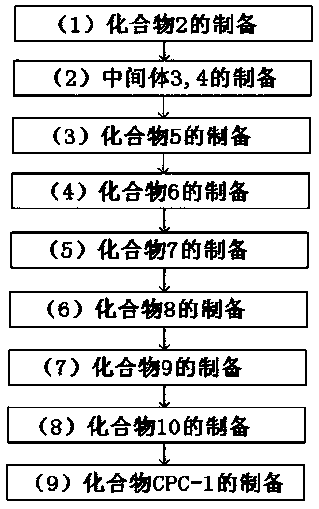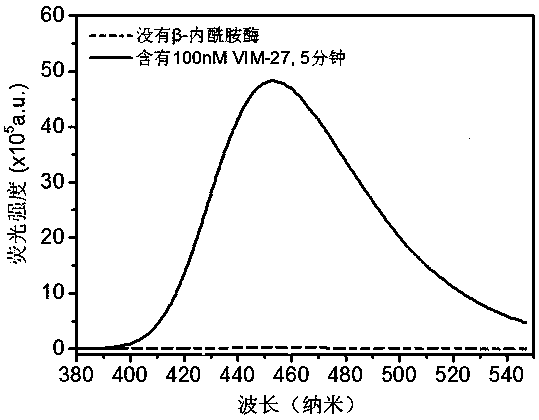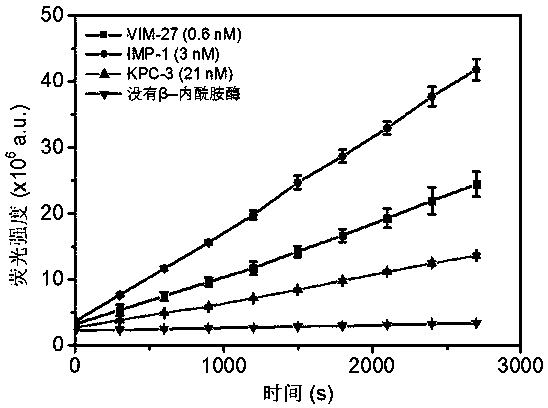Fluorescent probe for carbapenem type antibioticbacteria and synthesis method and application thereof
A carbapenem, fluorescent probe technology, applied in fluorescence/phosphorescence, chemical instruments and methods, luminescent materials, etc., can solve the problems of insufficient sensitivity and selectivity, short wavelength, etc., and achieve low cost and high selectivity sexual effect
- Summary
- Abstract
- Description
- Claims
- Application Information
AI Technical Summary
Problems solved by technology
Method used
Image
Examples
Embodiment 1
[0069] A method for synthesizing a fluorescent probe resistant to carbapenem antibiotics bacteria, the preparation method of its compound 2 is:
[0070] Under the protection of argon, add 20 ml of dry DMF solution of meropenem intermediate F9 into the reaction bottle (schlenk), and then add 3.62 g of tert-butyldimethylsilyl chloride TBDMSCl (2 mmol, 4 equivalent equiv) and 2.45 g of imidazole in sequence (36mmol, 6equiv); After reacting at 20°C for 5h, ethyl acetate was added, washed with water and saturated brine, dried over anhydrous sodium sulfate, concentrated and then purified by silica gel column chromatography to obtain a total of 2.95g of compound 2 as a white solid, The yield is 98%;
[0071] Its synthetic route and general structural formula are:
[0072] .
Embodiment 2
[0074] A method for synthesizing a fluorescent probe resistant to carbapenem antibiotics, wherein intermediates 3 and 4 are prepared by:
[0075] Get zinc dichloride 68mg (0.5mmol) and place reaction bottle bottle, add dichloromethane after drying, add compound 2 and rhodium tetraacetate (Rh 2 (OAc) 4 , under the protection of argon, the reaction system was heated to reflux for 90 minutes; the solution of intermediate 3 was obtained after the completion of the reaction was monitored by thin layer chromatography (TLC).
[0076] 7.6g (15mmol) diazo compound 2, 67mg (0.15mmol) Rh 2 (OAc) 4, 40mL of dry dichloromethane were added to the reaction flask in turn, under the protection of argon, the reaction system was heated to reflux for 90min, after the completion of the reaction was monitored by TLC, cooled to -55°C, 2,2,6,6- Tetramethylpiperidine 3.03mL (18mmol) and diisopropylethylenediamine 1.4mL (7.65mmol) were mixed and added dropwise for more than 15min; then, trifluoromet...
Embodiment 3
[0080] A method for synthesizing a fluorescent probe resistant to carbapenem antibiotics bacteria, the preparation method of its compound 5 is:
[0081] ZnCl 2 3.38g (24mmol, 1.8equiv) is placed in the reaction bottle, and the reaction tube is baked with an electric oven under vacuum; after cooling, add 20mL nitrogen methyl pyrrolidone (NMP), and after the system is cooled, degas under vacuum Substitute Ar three times; then add in turn the intermediate 4 prepared in Example 2 8.15g (13.5mmol), tris(2-furyl)phosphorus 275mg, Pd 2 dba 3 275mg (1.2mmol); Stir the resulting solution at room temperature at 25°C for 10min, then slowly add 4.8mL (16.8mmol) of tributylvinyltin; react the reaction system at 30°C for 10h, then use 150mL of ethyl acetate Diluted, washed twice with water and once with saturated brine, dried the organic phase with anhydrous sodium sulfate, and finally obtained 6.1 g of compound 5 as a white solid after column chromatography, with a yield of 93%;
[0082...
PUM
 Login to View More
Login to View More Abstract
Description
Claims
Application Information
 Login to View More
Login to View More - R&D
- Intellectual Property
- Life Sciences
- Materials
- Tech Scout
- Unparalleled Data Quality
- Higher Quality Content
- 60% Fewer Hallucinations
Browse by: Latest US Patents, China's latest patents, Technical Efficacy Thesaurus, Application Domain, Technology Topic, Popular Technical Reports.
© 2025 PatSnap. All rights reserved.Legal|Privacy policy|Modern Slavery Act Transparency Statement|Sitemap|About US| Contact US: help@patsnap.com



